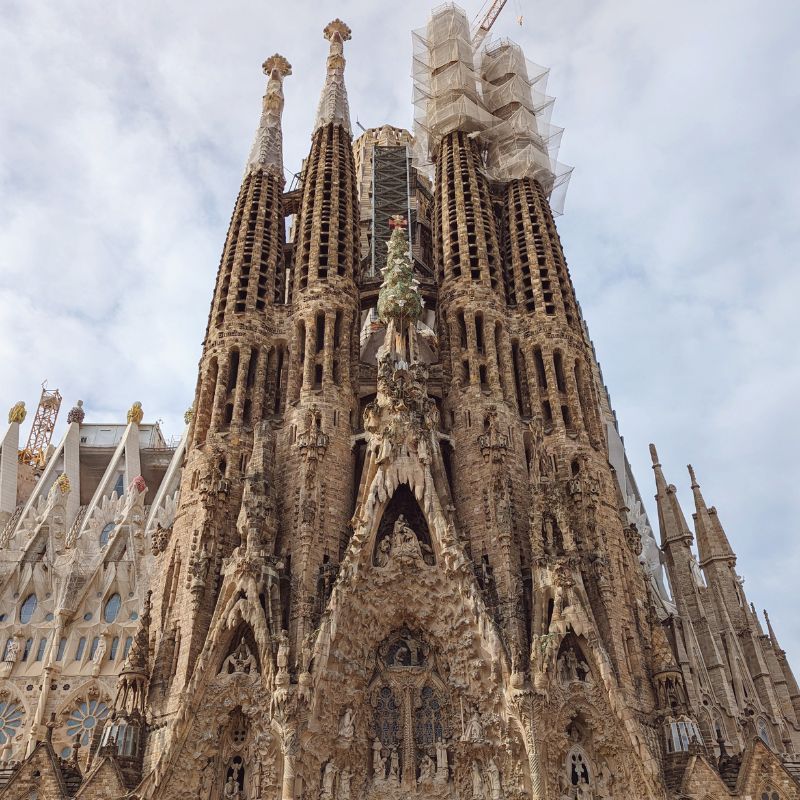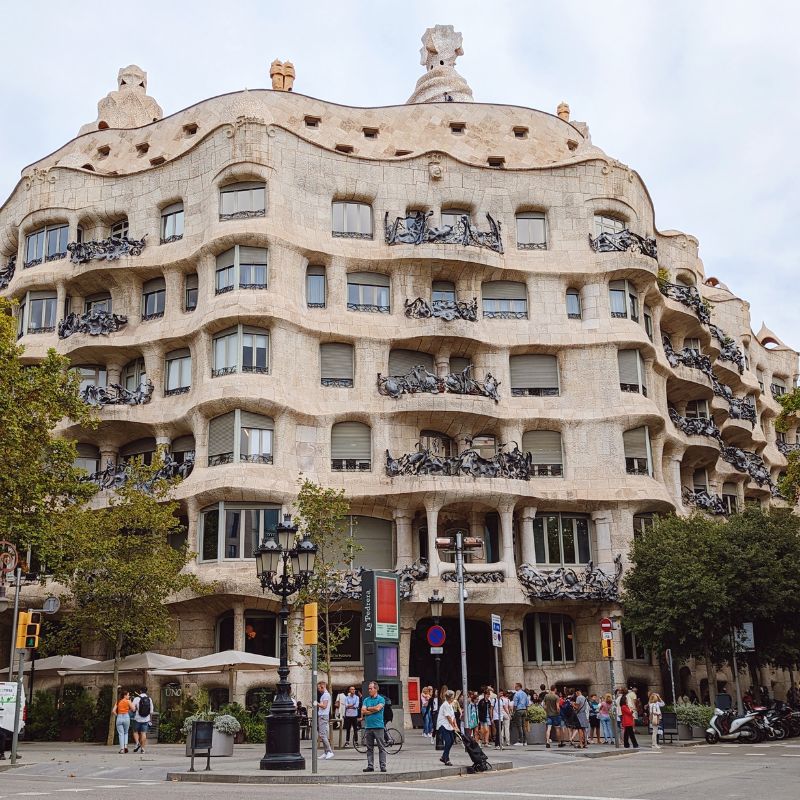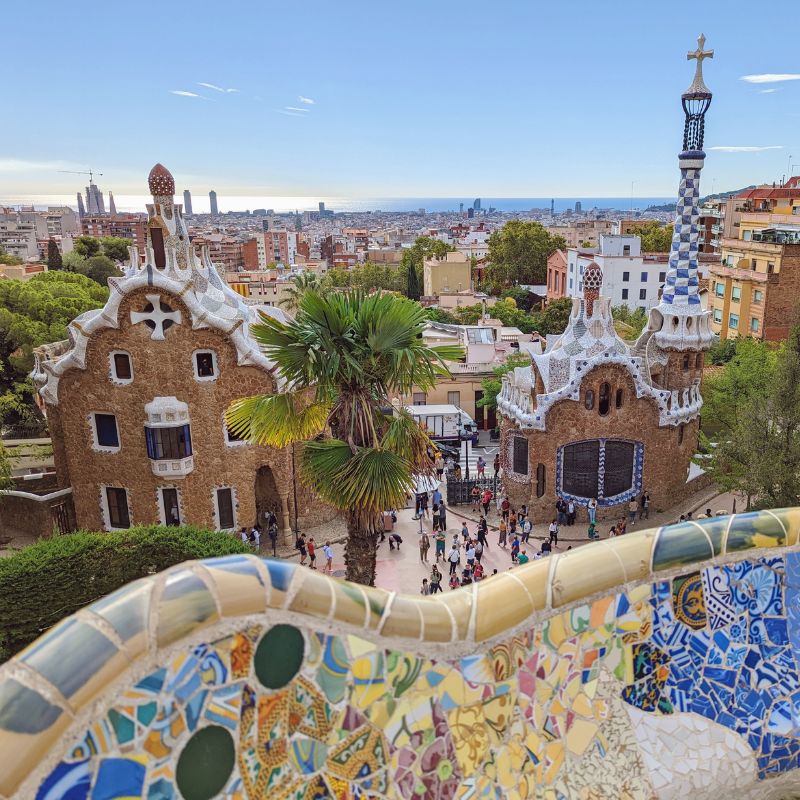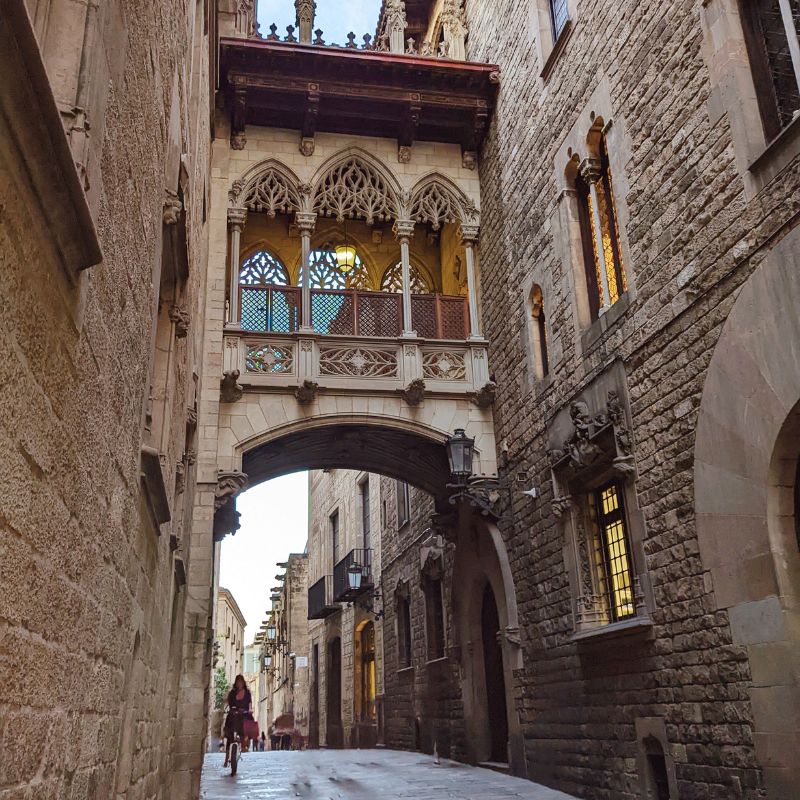Planning a weekend in Barcelona? This 3 day Barcelona itinerary is perfect if you’re visiting for the first time. It includes where to stay, where to eat, what to do, and how to make the most of your trip.
Barcelona will always have a special place in my heart because it’s where my husband and I celebrated our honeymoon.
It really is one of the best destinations in Spain for couples, families, and solo travelers to experience quirky architecture, a beautiful coastline, and Catalonian history.
Related Posts:
- Visiting Barcelona for the first time (21 tips & tricks)
- Visiting Madrid for the first time – (31 tips & tricks)
- 2 days in Madrid – Ultimate weekend in Madrid itinerary
Table of Contents
Things to know before traveling to Barcelona
When is the best time to go? Spring and early summer (April to July) is the best tim16te to visit Barcelona. This is when the weather is warm enough to enjoy the beaches, outdoor events, and festivals.
We went to Barcelona during the fall (September to November) when the are fewer crowds and the weather is mild. This can also be a great time to visit.
Where is the best area to stay? Barri Gòtic (Gothic Quarter), El Raval (near Barcelona Museum of Contemporary Art), El Born (near the basilica of Santa Maria del Mar), and Eixample (near La Sagrada Familia) are the best areas to stay in Barcelona.
The old town Gothic Quarter is an excellent location for first-timers to visit all the major landmarks and attractions.
What are the top 5 things to do in Barcelona? La Sagrada Familia, Casa Batllo (the most famous home designed by Gaudí), Palace of Catalan Music, Casa Milà – La Pedrera (Antoni Gaudí’s last civil work), and Camp Nou (FC Barcelona’s home and football stadium)
What is the best way to save money on attractions? Check which museums offer free days or specific hours (usually the first Sunday of the month). Or if you’re planning to visit a lot of attractions, consider getting a Barcelona city pass.
We found the Go City Barcelona Pass provided the best bang for your buck and it includes free entry to La Sagrada Familia, Casa Batllo, and Park Güell.
FLASH SALE! Save up to 10% off the Barcelona Pass. Offer ends July 21st. You have 2 years to activate the pass.
What is the best way to get around Barcelona? Public transport such as the metro, tram and FGC are the fastest and easiest ways to get around Barcelona.
If you’re staying in a central location like the Gothic Quarter, you can visit most of the city’s top attractions and landmarks on foot.
If you prefer to be comfortable and relax, you can ride the Hop-On Hop-Off Bus Tour, which is a great way to get to know Barcelona for first-timers.
What are the best hotels to stay at in Barcelona?
Best budget hotels in Barcelona:
- Hotel Jazz (Near the popular Plaça de Catalunya square)
- Hotel Soho Barcelona (Near the popular Plaça de Catalunya square)
- Andante Hotel (Within the lively Raval district)
Best mid-range hotels in Barcelona:
- Olívia Plaza Hotel (A 2-minute walk from Plaça de Catalunya square)
- Kimpton Vividora Barcelona (In the heart of the Gothic Quarter)
- Seventy Barcelona (Near Gaudi’s Casa Milà)
Best luxury hotels in Barcelona:
- Hotel Bagués (In Las Ramblas, near the Gothic Quarter)
- Claris Hotel & Spa (Near Gaudi’s Casa Milà)
- Hotel Casa Fuster (the Vila de Gràcia neighborhood)
Barcelona itinerary day 1 – The Gaudí sites
For your first day in Barcelona, you’ll visit Gaudí’s most popular sites in the city.
If you’re not already familiar with Antoni Gaudí, he is one of the most famous architects of the first half of the 20th-century. He’s best known for his unique and intricate structures throughout Barcelona.
La Sagrada Familia

Start your morning by heading to La Sagrada Familia. This is a Roman Catholic church that’s been under construction for over 100 years. Construction started in 1882 and builders are expected to complete construction in 2026.
Gaudí is the mastermind behind this UNESCO World heritage site and it’s the tallest religious building in Europe. After he passed away, his body was buried on the underground level in a tomb.
When La Sagrada Familia will be complete, it will have 18 towers. 12 towers will represent the apostles, two will represent the evangelists, one will be designated to the Virgin Mary, and the last one will represent Jesus Christ. Right now, there are only eight towers.
When you visit La Sagrada Familia, you have two choices – explore only the Basilica or go up the Nativity or Passion Towers after exploring inside.
The ticket you purchase will depend on what you want to see at the Basilica.
The cheapest and most popular option is to buy the Sagrada Familia fast track ticket, which is great for those who just want to explore inside.
If you want to go up one of the towers, you’ll need to buy the Sagrada Familia tower ticket.
It only costs slightly more than the regular entrance ticket, so you may find this worth it to go up the tallest religious building in Europe.
If you’re using the Barcelona Pass, you can enjoy a free guided tour of La Sagrada Familia (a €60.00 value).
Simply click the link to buy your pass. Then when you’ve finalized your itinerary, you can book your spot to visit on your preferred date and time.
Going up the towers is easy because you don’t have to climb any stairs. Each tower has an elevator that takes you right to the top.
However, to get down from the towers, you’ll have to take the stairs. Plan to spend at least 30 minutes visiting one of the towers.

Which tower is better – the Nativity facade or the Passion facade?
Most visitors who visit both towers say they enjoyed going up the Nativity facade best. This seems to be everyone’s favorite tower.
A few reasons why you’ll want to go up the Nativity facade is because Gaudí built the tower himself. There is also a bridge that connects the two towers of the Nativity facade, so you can enjoy incredible views when you walk across the bridge.
The view from the Nativity tower is the city and the mountain range behind Barcelona. The view from the Passion tower is the ocean. I think a view of the city is better than the ocean.
Tips for visiting La Sagrada Familia
The best time to visit to avoid crowds is at 9:00am in the morning when it opens.
If you choose to go up on the Sagrada Familia’s towers, this is also the best time to go (between 9:00am and 11:00am) when there are fewer crowds.
If you want to get a more in-depth experience, I highly recommend taking a tour of the La Sagrada Familia. It’s a great way to learn more about the symbolism of the Basilica, such as why there are turtles on the facade.
Plan to spend around two hours exploring La Sagrada Familia thoroughly.
After visiting La Sagrada Familia, the next stop is to grab lunch near Passeig de Gràcia. This is one of the most famous boulevards in Barcelona for shopping and business.
I really enjoyed eating lunch at Honest Greens on Rambla de Catalunya. It’s an affordable restaurant for healthy and delicious food.
My husband and I shared a hummus plate and I had a big mexican style salad.

On Passeig de Gràcia, you’ll find a few homes built by Gaudí or inspired by his work. I recommend visiting at least one of the casas, with the most popular choice being Casa Batlló.
If you’re using the Barcelona Pass, you can get free entry to Casa Batlló, Casa Amatller, and Casa Vicens. If you’re a fan of Gaudí and his work, the Barcelona Pass can save you a lot of money and time when sightseeing.
FLASH SALE! Save up to 10% off the Barcelona Pass. Offer ends July 18th. You have 2 years to activate the pass.
Casa Batlló

This is another of Antoni Gaudí’s main projects and one most iconic buildings in Barcelona. A UNESCO World Heritage site, it’s also known as Casa dels Ossos (House of Bones).
This is because of its skeletal and animal-inspired appearance. The arched shape of the roof and tile design resemble the scales of a large dragon.
Tips for visiting Casa Batlló
Over 1 million people visit this site each year, so if you’re a big fan of Gaudí, you’ll want to buy your tickets in advance to avoid waiting in a long queue.
Weekdays (Monday – Thursday) are the best time to visit Casa Batlló when there are fewer crowds.
If you’re traveling on a budget, you can view the building and take photos from the outside. But for those who love Gaudí and his work, it’s worth paying to go inside.
If you’re using the Barcelona Pass, you can visit Casa Batlló for free. They recommend visiting between 12:00pm and 3:00pm or after 6:00pm to avoid the busiest times.
Casa Milà

Built in 1912, Casa Milà (La Pedrera or The Stone Quarry) is a building designed by Gaudí and was his last complete commission.
It’s been declared a World Heritage site by UNESCO and is located a short walk from Casa Batlló on Passeig de Gràcia.
From the outside, the building resembles an eroded stone cliff which is visually broken up with its balconies made of wrought-iron railings.
The roof terrace provides a spectacular view of Barcelona. The terrace pathways are filled with wavy floors, Gaudí-style sculptures, ventilation towers, and 28 chimneys.
Tips for visiting Casa Milà
While not as busy as Casa Batlló, during the high season and busier times of year, it’s recommended to purchase your tickets in advance to avoid long queues.
The afternoons (after 4:00pm) is usually the quietest time to visit the building. Plan to spend around 1.5 hours here.
If you’re a big fan of Gaudí, then consider taking a guided tour of Casa Milà. This can give you a better understanding of the building and access to off-limit areas such as the first floor corridor and the back facade.
If you want to get an afternoon snack, Sam and I really enjoyed going to La Cava Cakery. Here you can get a glass of Cava, Spain’s version of champagne, and a delicious cupcake.

Casa Amatller
Just a short walk from Casa Milà, you’ll find Casa Amatller by Puig i Cadafalch, who is a contemporary of Gaudí. It’s a beautiful example of Modernism in Barcelona and combines elements of neo-Gothic style and Dutch urban architecture.
What makes this building special is that many of the original furniture and decorations are still there for visitors to see. You’ll feel like you’ve been transported back in time while touring Casa Amatller.
After visiting the building, the tour ends with a tasting of a cup of Amatller chocolate.
If you’re short on time, you can admire the building from the outside and take photos. You can also check out the chocolate shop to enjoy Chocolate Amatller. This is one of the oldest active chocolate brands in Europe.
Casa Vicens Gaudí
Casa Vicens is the first of Gaudí’s works in Barcelona and was declared World Heritage Site by UNESCO in 2005. The building is covered in beautiful green and white tiles and is considered to be one of the first masterpieces of Modernism.
When you buy your tickets for Casa Vicens, you must select the time and date of your visit. This is because they do small group tours in the casa.
They recommend arriving no more than 10 minutes before the indicated time slot on your ticket to avoid queues outside.
Palau Güell
Palau Güell is one of the first commissions Gaudí received at the beginning of his career. This palace is a great example of domestic architecture of Art Nouveau.
Unless you’re a big fan of Gaudí and want to check out the view of Barcelona from the rooftop, I would just take photos outside the building.
Barcelona itinerary day 2 – Gothic Quarter, La Rambla, and Park Güell
Today you will explore the heart of Barcelona (the Gothic Quarter) and Park Güell.
Start your morning by heading to Park Güell. The early morning hours between 9:30am and 11:00am on weekdays are the best time to visit Park Güell to avoid crowds.
Park Güell is a massive garden and privatized park system with beautiful architectural elements designed by Antoni Gaudí. Spread over 18 Hectares of hilly land, it is one of the most visited attractions in Barcelona.

How to get to Park Güell
The best way to get to Park Güell is by metro. Take the green line L3. You can get off at either two stops: Lesseps and Vallcarca, which are a 20-minute walk from the nearest entry point, Sant Josep de la Muntanya.
If you prefer to ride the bus, take the H6 and D40 bus route which will stop at Travessera de Dalt. This stop is just a 10-minute walk from both Sant Josep de la Muntanya and Carrer de Larrard.
You can also take the 24 and 92 bus route which stops at Carretera del Carmel-Park Güell.
Tips for visiting Park Güell
Buy your tickets in advance: To avoid waiting in a long queue, you’ll want to buy your tickets in advance. This saves you money and time so you can enjoy more time exploring the park.
Tickets often sell out early during the day, so if you have your heart visiting Park Güell on a certain day, make sure to buy your tickets in advance!
If you’re using the Barcelona Pass, you can enjoy a free guided tour of Park Güell (a €32.00 value).
Simply click the link to buy your pass. Then when you’ve finalized your itinerary, you can book your spot to visit on your preferred date and time.
Avoid the main entrance: If you purchased your ticket in advance, you can enter at any of the entry points. This is helpful is the main entrance is really crowded.
Be prepared to do a lot of walking: Park Güell is an enormous park, so you’ll want to wear comfortable walking shoes and keep your carry ons to a minimum weight. There are both hills and stairs in the park.
There are also no luggage lockers at the park, so try to avoid bringing heavy items that you can’t carry with you around the park.
Bring food, drinks, and sun protection: The food and beverages for sale at the park can be expensive, so you’ll want to pack your own water and snacks. And if you’re visiting during the summer, don’t forget to apply sunblock and use appropriate sun protection.
Mercado de la Boqueria
Mercado de La Boqueria is the largest food market in Barcelona, located right on La Rambla. It’s open all day with free entry and has 330 stalls selling high quality products.
This can be a great spot to stop for breakfast or lunch after visiting Park Güell. The restaurants inside La Boqueria are tiny Barcelona bars where you can sit for snacks, but keep in mind that space is limited.
If you just want to browse the market and go to a quieter place for lunch, check out Bun Bo Barcelona located in the Gothic Quarter. It’s a cute Vietnamese with a nice patio in the summer months.

La Rambla
After lunch, it’s time to explore La Rambla, which is a pedestrian-only throughfare in central Barcelona.
This area is famous for its lively atmosphere, cafes, restaurants, flower shops. At the top of La Rambla, you’ll find Columbus Monument, which is a tall monument to Christopher Columbus.
When walking around La Rambla, always keep an eye on your belongings. Since this is a popular tourist spot in Barcelona, there are tons of pickpockets here.
I always felt safe while walking here, but like any big city in the world, it’s always a good idea to pay attention to your surroundings.
Gothic Quarter

Just a short walk from La Rambla, you’ll find yourself in the Gothic Quarter (Barri Gòtic), which is the heart of Barcelona.
This area has narrow medieval streets lined with trendy bars, clubs, shops, and restaurants featuring Catalan cuisine and ethnic eats.
We booked out hotel accommodations in the Gothic Quarter, which provided the perfect base for exploring Barcelona. This made it easy to get around to all the main landmarks and attractions on our sightseeing itinerary.
In the Gothic Quarter, you can learn about Barcelona’s Jewish Quarter (El Call) and see the remains of the Roman city in the Museu d’Història de Barcelona.
If you have time, I highly recommend taking a walking tour of the Gothic Quarter. This is the best way to learn more about the unique history and legends behind Barcelona’s oldest district.
Depending on the tour you decide to take, some include fun activities such as trying Catalan cuisine or drinking quality coffee.
If you’re using the Barcelona Pass, there are a few walking tours included for free with your pass:
- Old Town and Gothic Quarter Walking Tour
- Tapas Tasting and Gothic Quarter Tour
- Barcelona Markets Tour: Boquería, Tastings and More
While you’re exploring the Gothic Quarter, you’ll notice two beautiful churches in the area: Barcelona Cathedral and Basilica of Santa Maria del Mar.
At the end of the day, it’s nice to have a drink and people watch in Plaça Reial. This is a popular square in Barcelona decorated with a fountain, street lamps, and palm trees.
We went to Espai Quera, which is a cozy restaurant tucked behind a travel bookstore.

Barcelona itinerary day 3 – Exploring the city
For your last day in Barcelona, this is a good chance to explore the rest of the city or use this as an opportunity to take a day trip.
Camp Nou

In the morning, you have a couple of options. If you’re a big fan of football or want to learn more about the largest stadium in Europe, then check out Camp Nou.
Spotify Camp Nou is the home of FC Barcelona. It’s a massive stadium that hosted both the 1972 and 1982 Winners’ Cup Finals. You can take a tour inside the stadium to get an up close look at this prestigious football club.
During the tour, you’ll get to visit the locker rooms, walk down the tunnel to the field just like the football players do, and onto the grass where so many great games have been played.
There is also a museum where you can check out the gallery of trophies and the official FC Barcelona store.
The best time to visit Camp Nou is between 10:00am and 3:00pm on weekdays during October to March. This is when there are fewer crowds so you can avoid the queues and explore the stadium at your own pace.
If you’re using the Barcelona Pass, you can enjoy a free tour of Camp Nou.
Parc de Montjuic

The other option is to head to Parc de Montjuic in the morning. This is a free beautiful park that provides stunning views of the city.
We went here first thing in the morning after having breakfast at Billy Brunch. It’s beautiful to visit during the spring, summer, and fall months.
At the top of the hill in the park is Montjuïc Castle, which was built as a military camp in 1640. You can get to the castle by walking or if you want to give your feet a rest, ride the Barcelona Cable Car (funicular).
Whether or not you choose to tour the castle, going to the top of the hill is well worth it for the incredible views you’ll get of Barcelona.
If you’re using the Barcelona Pass, you can enjoy a free Montjuïc Walking Tour (a €29.00 value).
Palau Nacional and the National Art Museum of Catalonia

After exploring the hilltop, make your way down to the the Palau Nacional. This building was the main site of the 1929 International Exhibition and since 1934, it’s been home to the National Art Museum of Catalonia (Museu Nacional d’Art de Catalunya).
Here you’ll find the largest collection of Catalan art in the world. You could easily spend 2 hours exploring the museum, so make to sure to budget enough time if you want to visit.
Even if you don’t go inside the museum, it’s still worth checking out the surrounding area. My husband and I enjoyed having a cup of coffee on the plaza in front while people watching.
The Magic Fountain
At the bottom of National Art Museum of Catalonia, you’ll find the Magic Fountain. Watching a performance at this fountain is one of the most popular things to do in Barcelona.
From Thursday to Sunday during the summer months, you can catch a 15-minute show several times a night. It’s similar to the fountain show at the Bellagio hotel in Las Vegas where the water jets will do a dance set to a soundtrack of classic a pop music hits.
Palau de la Musica Catalana

After visiting Parc de Montjuic in the morning, head to the Gothic Quarter to grab lunch.
We loved our meal at La Cereria. They have a variety of delicious vegetarian food which my meat-eating husband even enjoyed.
After lunch, consider checking out Palau de la Musica Catalana. This is a popular concert hall in Barcelona designed by the architect Lluís Domènech i Montaner and showcases Catalan modernista style.
It was built in the early 1900s, during the same period Gaudí was working on Casa Batlló.
While you can attend a concert here, it’s much cheaper to take a guided tour of the building. This was one of our favorite things to do in Barcelona and it’s worth paying to see the interior.
It can get quite busy during the summer months, so I recommend buying your tickets in advance to save time and money.
Since there are many stain glass windows in the building, try to visit on a sunny day. Mornings and sunsets are especially nice for photos.
Parc de la Ciutadella
Parc de la Ciutadella is a spectacular green oasis inside the hustle and bustle of Barcelona. This is the perfect place to go for a long walk, have a picnic, attend a festival, a rent a rowing boat on the lake.
If you’re using the Barcelona Pass, you can also check out the Barcelona Zoo which is located inside the park. Free entry is included with your pass.
Arc de Triomf

Just outside the Parc de la Ciutadella, you’ll find the Arc de Triomf. The arc was built in 1888 when Barcelona hosted the Universal Exhibition as a gateway to the fair.
This is a popular spot where you’ll see joggers, people walking their dogs, and tourists. But if you come in the morning (just after sunrise), you can take some incredible photos here.
